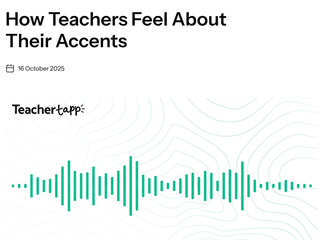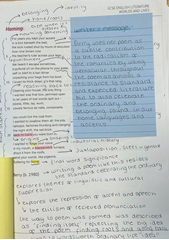During discussions around both formative and summative assessment, teachers involved in the Rethinking Assessment project kept coming back to the topic of talk. They felt strongly that listening to, engaging with and responding to student talk in English was a valuable way of formatively assessing students, and that using more creative and open-ended tasks, as well as including more opportunities for self and peer assessment, meant that students were talking more, and with more purpose, in their classrooms. What follows are some examples of how talk worked in teachers’ classrooms during the project. The findings are from conversations with teachers, mostly at Kiteford School.
Talk for ideas
In an interview with the Research & Projects team towards the end of the project, Vachana at Kiteford explained how the shift in focus back on to varied lesson tasks (see Part 5) and formative practice had opened up space for students to talk productively about their own ideas. She thought that a focus on ideas was lacking in much practice and vitally important to work on:
[Students’ owning their ideas is] the seismic shift that needs to happen, I think. Because one of the things that we were discussing was [...] how authentic is your understanding of the text you are writing about and how genuine are your ideas or is it bog-standard stuff that you’re picking up. And that only comes when students take ownership of the text that they’re reading and this enables that.
She went on:
For so long we have focused on technique rather than focusing on the ideas and how we – in our emotions, with our feelings, even sometimes with our senses – respond to a text. We are not teaching that enough. Or asking ‘how did it make you feel [...]’ I’ve found myself going ‘okay how you’re feeling is fair but tell me why you’re feeling like that’ so I probe further, which effective questioning is all about right? And this allows for that.
Talk and moving students on
In a department meeting towards the end of the project, the teachers at Kiteford discussed how the talk in their classrooms had played out during the project, noticing how they could respond much more meaningfully during exchanges with their students by shifting the emphasis from getting to the end of the unit to what was happening in the moment during a lesson. Vachana told an anecdote about one of her Year 9 students, in which talk between the teacher and the student played a really important role in extending both the student’s thinking and the teacher’s understanding about the student at a moment in time:
One of the students who is EAL, when she heard Amanda Gorman’s speech [...] I said “well what did you think of that?” and she said “to be honest I didn’t understand a word”. Now, I could’ve reacted to that by going “well you’re not listening” or blah blah blah... I found myself saying “ah that’s fair. Will you tell me why?” and she was then able to say “because she wasn’t speaking in sentences and I couldn’t follow the... how it was flowing” and it was such a good opportunity to then be able to say “ah she was doing free verse! That is a style in poetry and you’re not supposed to totally get the gist of what she’s saying because it’s not a speech, it’s a performance.” And it just opened the door for her to go “oooohh so poetry can be free verse and I don’t have to always rhyme everything” And I don’t know if it would’ve happened if I was very strictly following something on the board that said “you must do this... you must do this... you must do this...” She was able to respond organically, and I was able to meet her where she was.
Talk for student engagement
Talk was also shown to be a powerful tool for transforming an activity and getting all students engaged in a lesson. In a department meeting at Kiteford, we heard about Vachana’s first lesson with her Year 9 class in their rhetoric unit, where she asked the class what they thought rhetoric was. The students had only heard of rhetoric in relation to rhetorical questions. Instead of simply giving the students a definition of rhetoric she decided to show them. What follows is Vachana’s description of her classroom during this activity:
I asked them to choose a menial thing, anything like a pen or a hair band.
“alright… give it a value.”
“Okay you’ve given it a value. Give it a really big value. So £500 for a hair band.”
“Okay now sell it to someone in the class. Go and sell it to someone in the class and see if they’re going to buy it. You really have to make it saleable. You’ve got one minute to plan in your head your spiel. Go!”
So they’re thinking, thinking, thinking, thinking and then suddenly the class is in chaos. Everybody is up and “£500 for this pen! £1000 for this!”
“Actually this is invaluable because AI is dead and you all have to write and this is the only pen left…”
So then when we stopped, there was an understanding of persuasion. Then we could have a conversation about what rhetoric is.
“Okay so now you know what rhetoric is let’s see how that’s played along in different contexts and different times” and that engaged them, so I think we need to have some more active aspects to the lessons so that it’s not just replicating but they begin to own rhetoric.
While talk in a unit on rhetoric might seem obvious, this activity could easily have just been students copying down a definition into their books. Instead, they could practice the ideas crucial to rhetoric through talk and were more likely to have a lasting and genuine sense of the term and its meaning.
Talk for self and peer assessment
In the last blog we showed you some examples of peer assessment from the project where written peer feedback wasn’t always effective. A teacher at John Stone suggested a useful alternative that required students to talk about and reflect on their work:
In the past when you swap books, you’ll get some ticks if you’re lucky and ‘really well done write more next time’. What I’ve started to do now... they have to... so if it was you and I working together now and this was my book... I’d have a green pen, not you. I have to tell you what I think the best sentence in my work is. I have to underline it, I have to talk you through it, then you give me some feedback... and I’m finding that is working a lot better than ‘swap books, mark each other’s’ because there’s actually no discussion, they swap the books back and the comments aren’t very helpful.
This idea, of students narrating their own work to a partner and justifying their choices as a writer verbally encourages conversation that generates more genuine and thoughtful response, perhaps because the pressure to imitate a teacher’s comment is removed and instead, students can talk about how a piece made them feel or ask questions to the writer that would otherwise have been ignored. Talk becomes an opportunity for more genuine engagement between peers discussing their work.
Time to get talking
During the project, teachers at both Kiteford and John Stone realised how much formative information they collect from student talk and how it shapes their decisions about adapting lessons going forward. EMC has always advocated for the importance of talk in English, with the project reinforcing how crucial it is for students to generate knowledge, try out ideas and consolidate their understanding in lessons. With oracy now firmly back on the agenda and an Oracy Education Commission established ‘to provide a blueprint for a national entitlement for oracy education at all stages of statutory education in England’, it might be a useful time to start talking to your teams about talk.
Below are some statements that might be useful as a stimulus for discussing the role of talk in English lessons with your department.
Statements for discussion
- Talk in English is a cornerstone of our pedagogical approach
- We should represent student talk in the data we gather for reporting.
- If talk is done well in English, we should see its impact in student writing.
- Talk is at least as important as reading and writing in English.
- We are always listening and gathering information from student talk.
- We adapt our lessons based on student talk.
- Talk is a reliable and valid way to formatively assess students.
- Talk is different to reading and writing in English – some students don’t say as much as others.
- Talk is an inclusive practice in English.
- Talk increases motivation and engagement in the classroom.
- Students talking more in the English classroom can have a positive impact on whole school behaviour/teaching & learning policies.
Let us know if you have any thoughts in the comments, and look out for Part 8 of our series, where we’ll be thinking about how a range of student work can be used for summative judgments and reporting in English.





